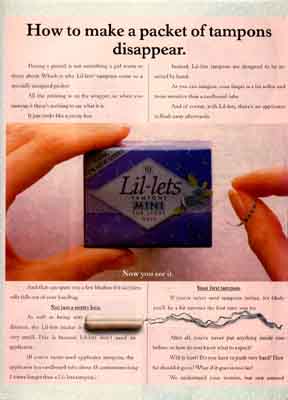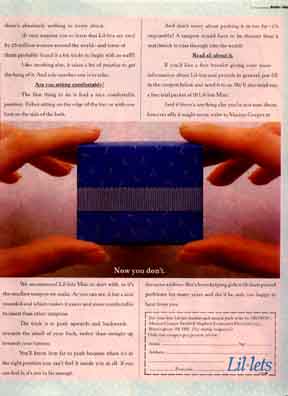See Lil-lets tampons and instructions from South Africa (1978)
And, of course, the first Tampax AND - special
for you! - the American fax tampon,
from the early 1930s, which also came in bags.
See a Modess True or
False? ad in The American Girl magazine,
January 1947, and actress Carol
Lynley in "How Shall I Tell My Daughter"
booklet ad (1955) - Modess
. . . . because ads (many dates).


|

Lil-lets
advertisement, "How to make a packet
of tampons disappear" (in a magazine
from the United Kingdom, October 1988)
Although Lil-lets is a popular
tampon outside the United States, this
ad shows the same concerns American
women have had since, well, since the
country was founded, probably.
The Johnson & Johnson company,
which made Modess pads, commissioned a
study
(presented in 1927) from Dr. Lillian
Gilbreth, the famous efficiency
expert, to find out what women wanted
in pads. One of the things Dr.
Gilbreth discovered applies to both
pads and tampons today and shouts in
this advertisement: American women
wanted the product and the box to be inconspicuous.
Commercial
tampons had not appeared when the
Gilbreth report appeared (women
could probably buy the first ones in America in the
early 1930s), but they incorporated
this quality in a way a pad never
could because they disappeared
inside the body. By the way, like
the first commercial tampons,
Lil-lets has no insertion device.
Tampax, in 1936, introduced this
stroke of genius. (An Australian
doctor introduced the applicator menstrual
cup–Gynaeseal– in the 1980s, but
the product failed, although I've
heard that it may not be dead. Some
day I'll put what I know about this
on the site.)
Now to get rid
of the box! Lil-lets also follows
Dr. Gilbreth's advice: reduce or
take off the writing!
Folks who
object that menstrual products
companies should make people more
tolerant of things menstrual rather
than exploit their fears ignore the
task of the businesses: to make
money. The famous ad man David
Ogilvy said that advertising aims
not to change society but to
discover what people believe and
exploit that to sell products. It's
something I halfway accept while
regretting it.
|
|

|
 |
The ad covers two facing pages
in the magazine.
|
Below:
the six sections, enlarged.
|
|